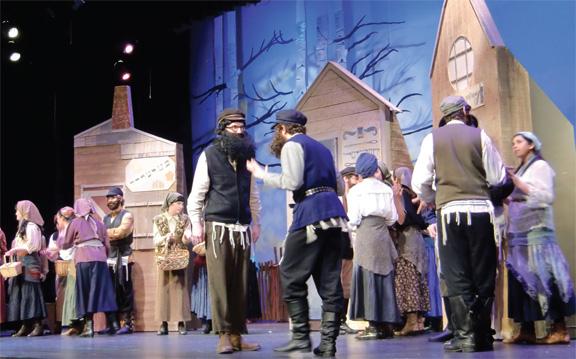
Hockaday set design crew creates the world of impoverished Russia for this winter’s musical
Hockaday’s set design crew created lifelike and multifaceted designs for the winter production, “Fiddler on the Roof.” The Set Crew was not only experimenting with different types of buildings and props, but also with new techniques, such as using furniture sliders.
This year, the sets “become more 3-D since the story is more 3-D,” said set director of “Fiddler,” Robert Kallos.
Based in an impoverished Russian city in 1905, “Fiddler on the Roof” is about three poor sisters who fall in love despite their Jewish traditionalist father, Tevye. The theme and temperament of “Fiddler on the Roof” drastically differs from the playful and fanciful attitude of last year’s musical, “Seussical.”
Unlike last year’s “Seussical,” which allowed designers and builders to, in a sense, cut corners with its many flats, or fake walls, “Fiddler” required more fully fleshed sets. The Tailor Shop, for example, flipped around, allowing the audience to see both the storefront and the inside of the Shop. The Barn and Tevye’s House, the only two stationary pieces, were designed in a way so that the ‘fiddler,’ played by Charlotte, was able to climb onto its ‘roof’ through secret stairs.
To make a three-dimensional set piece in accordance with the time period, the set crew had to spend more time on each set piece by perfecting details and adding props.
“We struggled to come up with the buildings for the village,” Junior Leia said. “No matter what it was that we drew, Kallos was always looking for ‘more.’”
Because “Fiddler” is set in the early 1900s, Kallos said making pieces look “of age and not new” was “the greatest challenge.”
With little time during the actual production to move sets and furniture, the set crew was testing several, efficient methods: one of which is the tool commonly associated with movers–furniture sliders. By using this technique, it eliminated the use of bulky wheels and made the sets look more realistic.
For the color palette of “Fiddler,” Kallos and design heads Lizzie and Leia chose a wide range of colors. This gave the set design students the liberty to choose a variety of colors in order to complete their vision of a specific set piece.
Under Kallos’ leadership, the set crew has grown from single digit participation four years ago to the 30 Hockaday and St. Mark’s students who work collaboratively on musical sets to build “one big, giant sculpture,” Kallos says.
Set ideas flow first to the Story Board, a collection of pictures, drawings and other influences pinned to a bulletin board in the Fine Arts hallway.
Set crew and design member sophomore Kellen said that the Story Board is important to “help keep our ideas in order, give us reference while we’re designing, let us know what set pieces we need for each scene, and give the design crew a place to put their finished sketches.”
Not only did the students help design and create the sets, but they reused and recycled props and parts of sets from past musicals. This year, the Set Crew repainted and refurbished many of its pieces including tables and mugs from “Oliver!,” working doors from “The Boyfriend,” and planks of wood from “Mame.”
Any scraps that can’t be used in the complex designs were often given to the first-grade art teacher, Dee Mayes, to be used for art projects.
While the set crew may not be seen or heard during the production, the results of their hard work and creativity could be viewed throughout the run of “Fiddler on the Roof.”
Leia remarked “it’s all good fun and definitely worth it in the end.”
– Meredith

